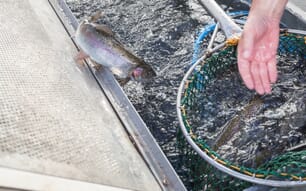
Photo: Bjørn Erik Brudeseth
The VHS virus is known to occur in wild marine fish. The Baltic Sea, for example, has a high incidence of infected fish, in particular herring.
For his doctorate at the Norwegian School of Veterinary Science, Bjørn Brudeseth carried out several marine surveys during the period 1997 - 1999 to study the incidence of VHS virus in marine fish in Norwegian waters, in collaboration with the Institute of Marine Research. A total of 4,653 samples were collected from the Norwegian Sea, The Barents Sea and the coastal waters of Lofoten, however, no VHS virus was found in any of these samples. One can nevertheless not discount the possibility that the virus exists there.
Samples were also collected from a total of 3,742 fish in the Skagerrak and along the coast of southern Norway. Of these, 2 samples tested positive, one from blue whiting and one from Norway pout. This discovery indicates that wild marine fish may be a potential reservoir of VHS virus for infection of farmed fish.
Marine VHS isolate less pathogenic in rainbow trout

In 2008, VHS was discovered in rainbow trout at a marine locality (Storfjorden) in Norway, with a possible marine source of infection. This discovery led to a lot of discussion because the marine form of VHS virus is in general relatively benign, in contrast to the freshwater form of the virus. Why this should be the case was, until now, not known.
Brudeseth's studies have revealed a possible explanation for the phenomenon. He showed for the first time that the marine form of the VHS virus, which spares the young of the rainbow trout, lacks the ability to infect the gill epithelium of trout fry. In addition, the marine form is unable to infect macrophages of the immune system of the fish. Macrophages are the cells that consume and eventually remove infection material. Infected macrophages are an important factor for the spread of the virus within the fish.
In other words, the "gentle" variants of the VHS virus lack the ability to traverse the outer gill barrier and in addition lack the ability to infect the fish's immune cells. The methods developed during the work on the doctorate create a solid foundation for characterising new variants of the VHS virus with regard to their abilities to infect fish. Bjørn Erik Brudeseth defended his D.Phil. degree, entitled "Novirhabdovirus infections of fish - with emphasis on VHS pathogenesis", at the Norwegian School of Veterinary Science on May 5, 2009.




